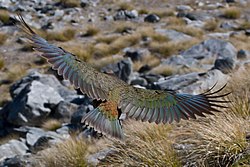Bird flight

Flight is a method of moving through the air. To do this, birds use wings with light, hollow bones and feathers on them. Birds have a streamlined body shape, so that they slip through air more easily.
Birds can move by flapping their wings, or they can stay in the same place. This is called hovering, with rapid wing beats, as with the kestrel. Birds that soar use very little energy for it: they use columns of rising hot air to lift them. They glide from the top of a warm air current, and then move on to another warm air current. That way birds like buzzards can fly all day while using little energy.[1]
Birds like hawks and gannets dive on their prey. They get to a height, them fold their wings and dive head-first.
Lift
The fundamentals of bird flight are similar to those of aircraft. Lift force is produced by the action of air flow on the wing, which is an airfoil. The lift force occurs because the air has a lower pressure just above the wing and higher pressure below.
Bird Flight Media
A flock of domestic pigeons each in a different phase of its flap
The downstroke of the wings generates lift and the wings are folded in during upstroke.
The ruby-throated hummingbird can beat its wings 52 times a second.
A hovering hummingbird traces out a figure 8 pattern (that resembles insect flight): The drag produced in each strokes cancel out while the lift balances the weight.
A male bufflehead runs atop the water while taking off.
A magpie-goose taking off
The budgerigar's wings, as seen on this pet female, allow it excellent manoeuvrability.
References
- ↑ Videler J.J. 2005. Avian flight. Oxford University Press. ISBN 0-19-856603-4









